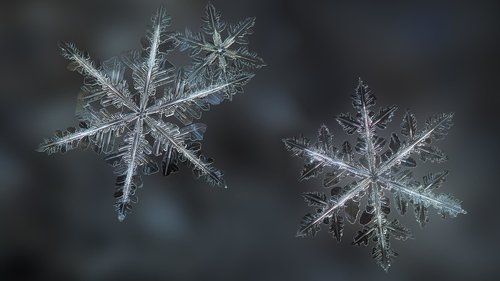Have you looked outside lately? With the new year now upon us, we are beginning to see the classic staple of living in this northern country: snow. White, soft, beautiful, all-encompassing snow. We watch, as each flake hits the ground, bringing us deeper into the winter season. But if you have ever paid close attention to the individual snowflakes as they fall, you’ve observed that each snowflake is different. Like snowflakes, people are unique, each having differences that deserve to be celebrated. To understand why differences are in our nature, we can look at how snowflakes come to be different.
Get ready for a small science lesson! Snowflakes are different due to the fact that they each consist of countless water molecules. The Washington Post states that, by one estimate, a snowflake may have up to a quintillion molecules! The process starts on the Earth’s surface, as water evaporates from large water bodies. In the wintertime, the cold air causes the water vapour to form into small liquid droplets, which condense onto nearby matter like pollen, forming tiny ice crystals. The crystals float through the air, and collide with water vapour molecules. As they collide, the water vapour goes directly from a gas to a solid, turning a previously miniscule ice crystal into a snowflake that will fall to the ground.
When these flakes first come together, they interestingly look quite similar; they all have a hexagonal lattice shape, due to the way hydrogen and oxygen bond to make water. Certain edges of the snowflakes are rough and jagged; these are the parts that attract more water molecules in hopes of becoming more uniform. The jagged arms have little amounts of water molecules added to them, causing them to grow into intricate snowflakes. Each snowflake keeps developing, for about 45 minutes to an hour, gathering more crystals on top of one another to form visible patterns. This causes the possibilities of a snowflake’s structural arrangement to be just about endless. This process is incredibly interesting, because if snowflakes simply stopped developing right after their formation, they would all be pretty much the same.
Yet with fluctuating temperatures, weather conditions, and physics, snowflakes take on distinct shapes and sizes. For example, ice crystals will only form between -2.8 and 0 degrees Celsius. If this temperature is lowered, the snowflakes will have thin, needle-like structures, or even “fern-like arms.’’ Humidity also affects the appearance of a snowflake, with lower humidity making them wider. Higher humidity develops their edges more, and also provides optimal conditions for packing snow!
When thinking about the amazing singularities of snow, I can’t help but think about how humans differ from one another as well. Each person has their own unique thoughts, experiences, and memories. No two people have lived the same life, meaning every single human has differing complex viewpoints on a variety of topics. Just like the crystals on a snowflake, we have undergone our own unique transformations, and our experiences shape the people we become. It’s absolutely mind-blowing!
This fact is not meant to make you feel trivialized, but to do the opposite. Although we may seem similar on the surface, every person is distinctive. Each and every one of us provides value to the world around them, just as each snowflake falls to form a beautiful winter wonderland.
So, the next time you look outside and see snowflakes descending one by one, be reminded of each one’s singularity. Marvel at the beauty of nature, and its ability to create billions of entities, each being exceptional and irreplicable.
Sources:
https://science.howstuffworks.com/nature/climate-weather/atmospheric/is-every-snowflake-actually-unique.htm
https://www.dw.com/en/life-cycle-of-a-snowflake/g-18148333#:~:text=It%20takes%20about%20an%20hour,more%20humidity%20cause%20larger%20flakes
Image Source:
https://www.chemistryworld.com/news/what-makes-a-snowflake-special/3008386.article
